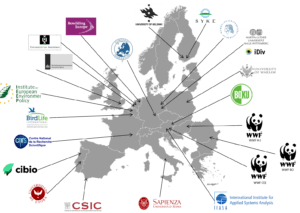NaturaConnect website is online!
Mas Larrieu National Reserve, France, Copyright EUROPARC Federation, Credit Lee Kershaw
Europe needs healthy ecosystems that benefit biodiversity and people and are resilient to climate change. The Horizon Europe NaturaConnect Project will support European Union governments and other public and private institutions in designing a coherent, resilient and well-connect Trans-European Nature Network.
Protecting and connecting nature across Europe
EUROPARC Federation is bringing its wealth of experience of Protected Areas by joining a new consortium under the Horizon applied research project NaturaConnect. The activities started in July 2022 and will run until June 2026.
What is the background for the NaturaConnect project?
In October 2020, European Union Member States committed to legally protect a minimum of 30% of the European Union’s land and sea area and to strictly protect at least a third of these protected areas. This is expected to contribute to the European Green Deal’s goal of preserving and restoring Europe’s natural capital as well as taking a leading role in the Post-2020 Convention on Biological Diversity (CBD) Framework.
One of the cornerstones of this strategy is to develop a coherent Trans-European Nature Network (TEN-N) to function as a connected system through ecological corridors with natural and semi-natural areas. If appropriately managed, this can deliver a wide range of benefits for biodiversity and people.
To help the European Union and its Member States to realize their ambitious strategy for protected areas, the European Union Horizon Europe Research and Innovation Programme funded the NaturaConnect project. NaturaConnect brings together 22 partner institutions*. The coordination is jointly managed by the International Institute for Applied System Analysis (IIASA), the German Centre for Integrative Biodiversity Research (iDiv) and Martin Luther University Halle-Wittenberg (MLU).
What does the project team do?
Working closely with protected area managers, conservation organizations, and other stakeholders, the project team will conduct research, engagement, and dissemination activities across Europe to identify the best areas to protect and connect to preserve biodiversity and adapt to climate change. The team will also work with national and sub-national nature conservation agencies and other stakeholders within six case studies to test and refine their approaches and inform local ongoing conservation efforts. One such example is the Carpathian-Danube region, where NaturaConnect will evaluate the connectivity design and implementation challenges in a trans-boundary area encompassing ten different European Union countries.
What are the project aims?
The project aims to:
- Support planning authorities, by collecting and making accessible the best available data and tools to assess biodiversity and the benefits to people
- Provide input to planning authorities into the design of an effective Trans-European Nature Network by anticipating future developments in climate and land use conditions that may limit or enable the development of such a network
- Identify alternative configurations of protected areas and corridors based on preferences related to policy targets
- Identify opportunities and challenges to the implementation of the network, mechanisms, and instruments of implementation, particularly financial instruments and ways to mitigate barriers through extensive dialogue with practitioners, capacity building, and decision support
- Showcase applications of the protected area network design through case studies
Who are the 22 partners?
Our partnership includes:
International Institute for Applied System Analysis (project lead; Austria); German Centre for Integrative Biodiversity Research (iDiv) Halle-Jena-Leipzig (project co-lead; Germany); Associacao Biopolis (Portugal); BirdLife Europe (Netherlands); Birdlife International (United Kingdom); Centre National De La Recherche Scientifique (France); Doñana Research Station – Agencia Estatal Consejo Superior De Ivestigaciones Cientificas (Spain); EUROPARC Federation (Germany); Finnish Environment Institute (Finland); Humboldt-University of Berlin (Germany); Institute for European Environmental Policy (Belgium); Netherlands Environmental Assessment Agency (Netherlands); Rewilding Europe (Netherlands); University of Evora (Portugal); University of Helsinki (Finland); University of Natural Resources and Life Sciences, Vienna (Austria); University of Rome La Sapienza (Italy); University of Warsaw (Poland); Vrie University of Amsterdam (Netherlands); WWF Central and Eastern Europe (Austria); WWF Romania and WWF Hungary.
Where can I get more information?
The project has a new website, where you can get detailed information about the work of the partners leading different technical areas and case studies as well as publications and research opportunities!
You can also follow the project on LinkedIn and Twitter


